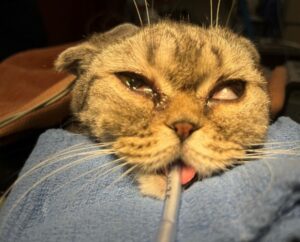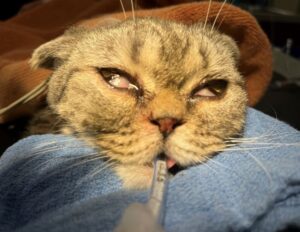Please find some common questions about the procedure below.
What is Brachycephalic Obstructive Airway Syndrome?
Brachycephalic Obstructive Airway Syndrome (BOAS) is a medical condition that commonly affects breeds with short noses and flat faces. BOAS is characterized by breathing difficulties, snoring, and other respiratory problems due to the anatomical characteristics of these breeds. These characteristics include an elongated soft palate, stenotic (narrow) nostrils and a hypoplastic trachea (under developed wind pipe). Sequela of chronic increased airway resistance from these characteristics include everted saccules and/or tonsils and laryngeal collapse.
What are common breeds effected by Brachycephalic Obstructive Airway Syndrome?
Brachycephalic dog breeds include Pugs, Boston Terriers, Shih Tzu, English and French Bulldogs.
Brachycephalic cat breeds include Persians, Himalayans, Burmese, British and Exotic Shorthairs.
What are common symptoms of Brachycephalic Obstructive Airway Syndrome?
Symptoms include: Noisy breathing, coughing up foamy saliva, heavy breathing including chest and stomach heaving, snoring, fainting, exercise intolerance, gagging while swallowing, difficulty sleeping or propping their head up while resting, and/or a blue tinge to the tongue and gums.
These symptoms may be heightened during or following physical activity, in hot environments, or in overweight pets.
How is the severity of my dogs airway assessed?
A sedated oral exam is necessary to assess the length of the soft palate to determine if it is too long. Under heavy sedation the function of the larynx (voicebox) can also be assessed to assess for masses, collapse and/or other dysfunctions. The presence of everted saccules and/or tonsils will also be noted during the sedated oral exam.
What are the components of surgery for Brachycephalic Obstructive Airway Syndrome in dogs?
Once a sedated oral exam has confirmed an excessive long soft palate in the back of the patients throat, a soft palate resection (staphylectomy) is performed using sharp excision. The palate is stretched and the excess tissue is removed with blade or scissors.

If the laryngeal saccules and/or tonsils are everted, they may be removed at the same time as the soft palate resection, or they may be left in and allowed to return to a more normal position.
Correction of stenotic nares consists of widening of the nostrils. Increasing nostril diameter helps improve breathing (see below image: pre-operative nostril on left, post-operative on right).

Staphylectomy, removal of saccules or tonsils and widening of stenotic nares can all be done at the same time during a single anesthetic event.
What patients are amendable to surgery for Brachycephalic Obstructive Airway Syndrome in a mobile setting?
Young patients, under the age of three, who are undergoing airway surgery on an elective basis are good candidates to have the procedure done in the comfort of their primary care veterinarians office by a mobile surgeon.
Any dog who is in respiratory distress or has a history of airway obstruction should undergo surgery at a specialty hospital offering overnight care. Older patients (typically over the age of 3) that have been suffering from chronic upper airway symptoms are more likely to have components of laryngeal collapse present (compromise to the structure of the voicebox). This recovery from anesthesia may contain more risks, and thus these patients should also have their surgery performed at a specialty hospital.
What potential complications may occur in the immediate post-operative period after Brachycephalic Airway surgery?
Airway surgery may cause inflammation or bleeding. If complications are severe, inflammation or bleeding can obstruct the airway, making breathing difficult. If this were to occur, a temporary tube must be placed and maintained through an incision in the neck into the trachea (temporary tracheostomy) until the swelling in the throat subsides enough that the pet can breathe normally.
Aspiration pneumonia may also occur during the recovery process. Brachycephalic breeds recovering from anesthesia are at risk of regurgitating and accidentally inhaling this regurgitation, resulting in secondary pneumonia. Pneumonia severity can range from mild to catastrophic.
Q: What post-operative restrictions are expected for a patient after Brachycephalic Airway surgery?
Although the stitches in the soft palate are dissolvable and not easily visualized, it is best to feed patients a soft or canned diet for 10-14 days after surgery to prevent abrading to the palate. Likewise, sticks, rawhides and other sharp/firm treats and toys should be avoided during the healing process.
Leash walks of patients should be performed in cooler weather (early morning, or after dusk). A harness should be used instead of a neck lead when walking these patients.
An Elizabethan (cone) collar may be needed for 10-14 days after surgery if the patient is pawing and rubbing at the nose. Some surgeons choose to place removable sutures in the nostrils, while others will use disposable.
What are the surgical options for brachycephalic cats?
Brachycephalic cats often have a large amount of upper respiratory noise due to small nostrils. Symptoms include snoring, snorting, and wheezing/whistling sounds. Cats can benefit from an alar fold resection to increase the size of their stenotic nostrils and thus increase airflow through the nose (see below image: pre-operative nostrils on left, post-operative on right).


